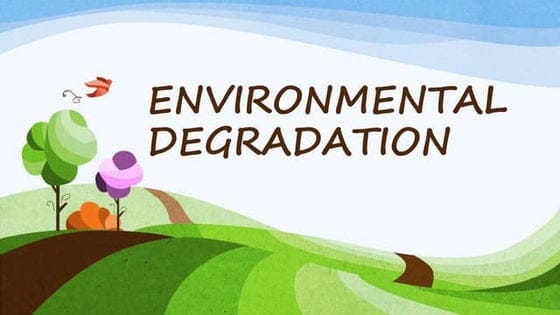Rapid population growth in a country like India is threatening the environment through expansion and intensification of agriculture, uncontrolled growth of urbanization and industrialization and destruction of natural habitats. The present paper is an attempt to study population change and its impacts on land, forest and water and energy resources. Rapid population growth plays a significant role in the degradation of agricultural land, forest and water resources per capita. The analysis shows that the consequences of high population growth rate are increasing population density and number of people below poverty line. Population pressure contributes to land degradation and soil erosion, thus affecting the productive resource base of the economy. Increasing population numbers and growing affluence have resulted in rapid growth in energy production and consumption in India. Environmental impacts such as groundwater and surface water contamination; air pollution and global warming are of growing concern due to increased consumption levels. The paper concludes with some policy reflections and emphasizes the potential importance of natural resources.
Introduction
The world has changed a lot since the 1960s and 1970s, when a virtual consensus existed among Western experts that rapid population growth in the developing world represented a serious global crisis. One of the primary causes of environmental degradation in a country can be attributed to the rapid growth of population, which adversely affects natural resources and the environment. Overpopulation and environmental degradation pose a challenge to sustainable development. The existence or absence of favourable natural resources can facilitate or retard the process of socio-economic development. The three basic demographic factors of births (natality), deaths (mortality) and human migration (emigration) and immigration (population moving into a country produces higher population) produce changes in the size, structure, distribution of population and these changes raise many important questions of cause and effect. Population growth and economic development are contributing to many serious environmental disasters in India. These include heavy pressure on land, land degradation, deforestation, habitat destruction and loss of biodiversity. Changing consumption patterns have led to increasing demand for energy. Its end results are air pollution, global warming, climate change, water scarcity and water pollution.
Rapidly growing population and economic growth is leading to many environmental issues in India due to uncontrolled growth of urbanization and industrialization, large-scale intensification of agriculture and destruction of forests. The major environmental issues are land, resource depletion (water, minerals, forests, sand, rocks etc.), environmental degradation, public health, loss of biodiversity, loss of resilience in ecosystems, forest and agriculture degradation leading to livelihood security for the poor.
The growth of population is leading to an alarming situation. The Population Reference Bureau estimated the world population at 6.14 billion in mid-2001. India alone contributed 1033 million to this population. It is estimated that the population of the country will increase to 1.26 billion by the year 2016. The projected population indicates that India will be the first most populous country in the world and China will be in second place in 2050. India has 18% of the world’s population. Its 2.4% of the world’s total area has increased pressure on its natural resources. Water scarcity, soil exhaustion and erosion, deforestation, air and water pollution affect many regions. If the world’s population continues to grow by leaps and bounds, the impact on the environment could be devastating.
Rapid population growth in a developing country like India is threatening the environment through expansion and intensification of agriculture, uncontrolled growth of urbanization and industrialization and destruction of natural habitats. As the population grows, the pressure on the environment intensifies every day. The increasing population trend and the resultant demand for food, energy and housing have drastically changed land-use practices and have also severely degraded India’s forests vis-à-vis the environment. The growing population has put enormous pressure on land expansion at the cost of forests and grazing lands as the demand for food could not keep up with the considerable increase in population.
Thus, the horizontal expansion of land has less scopes and it mostly depends on vertical improvement which is supported by technological development in the field of agriculture i.e. HYV seeds, fertilizers, pesticides, herbicides and agricultural implements. All these practices cause environmental degradation and depletion with multiplied proportions. Poverty is among the consequences of population growth and its lifestyle plays a major role in degrading the environment either by demanding fuel for cooking or for earning livelihood for their survival. Uneven distribution of resources and limited opportunities causes push and pull factors for people living below poverty line, which in turn increases the population density and environmental degradation multiplied.
Population Growth and Environmental Degradation
Population is an important source of development, yet it is also a major source of environmental degradation when it exceeds the threshold limits of the support systems. Unless the relationship between the multiplied population and the life support system can be stabilized, development programmes, howsoever innovative, are unlikely to achieve the desired results. Population impacts the environment primarily through the use of natural resources and the production of wastes and is associated with environmental stresses such as loss of biodiversity, air and water pollution and increasing pressure on arable land. Human population issues are extremely important when it comes to our lives and our future on this planet.
Poverty is said to be both a cause and an effect of environmental degradation. The circular link between poverty and the environment is an extremely complex phenomenon. Inequality can promote instability because the poor, who depend more on natural resources than the rich, depend more on natural resources because they have no real possibility of gaining access to other types of resources. Furthermore, the degraded environment can accelerate the process of deterioration, again because the poor depend directly on natural assets. Lack of gainful employment opportunities in villages and ecological stresses are leading to an increasing movement of poor families to cities. Mega cities are emerging and urban slums are expanding. Such rapid and unplanned expansion of cities has resulted in degradation of the urban environment. It has widened the gap between demand and supply of infrastructure services such as energy, housing, transport, communication, education, water supply and sewerage and recreational facilities, thus depleting the precious environmental resource base of cities. This has resulted in an increasing trend in deterioration of air and water quality, generation of garbage, proliferation of slums and undesirable land use changes, all of which contribute to urban poverty.
The direct impacts of agricultural development on the environment arise from farming activities that contribute to soil erosion, land salinization and nutrient loss. The spread of the green revolution has been accompanied by exploitation of land and water resources, and a manifold increase in the use of fertilizers and pesticides. Shifting cultivation has also been an important cause of land degradation. Leaching from the extensive use of pesticides and fertilizers is an important source of contamination of water bodies. Intensive agriculture and irrigation contribute to land degradation particularly salinization, alkalinization and water logging. Environmental degradation is the result of the dynamic inter-play of socio-economic, institutional and technological activities. Environmental changes may be driven by a number of factors including economic development, population growth, urbanization, intensification of agriculture, increasing energy use and transportation. Poverty, however, is still a problem at the root of many environmental problems.
Aims and Objectives
The aim of this article is to examine the impact of population growth on various aspects of the environment, which, every now and then, is gradually being degraded in India. Though the Census, 2011 has been completed, we do not have public access to current data about population growth and its associated factors and, therefore, we restrict our analysis to the data available from the Census Report, 2001.
Read Also:
- Environmental Effects Of Plastic Pollution
- Environmental Pollution: Causes, Effects, Solutions
- Environmental Pollution: Causes and Prevention
- Effects Of Environmental Pollution
- Causes Of Environmental Pollution
- Environmental Pollution
- Extents Of Environmental Degradation
- Introduction to Environmental Degradation: Causes and Effects






